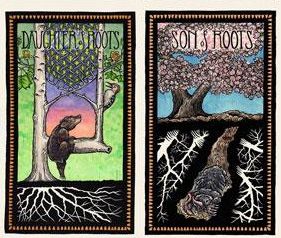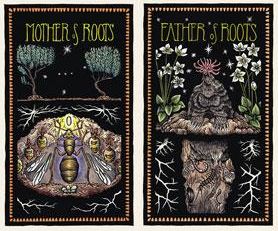Your cart is currently empty!
Last updated:
Tarot Deck Review – The Brady Tarot, 2nd Edition

I have finally found my perfect tarot deck! (It only took 20 years…) I used the Morgan-Greer deck as my primary deck for 13 years, with the intent of eventually getting a deck that is a bit more suited to me, but had a hard time finding one that spoke to me.
Last winter I was doing research for my second tarot workshop at UCMH, and I found a wonderful website called the Little Red Tarot. It’s an LGBTQ+-focused shop (and blog) that sells and promotes indie decks. That’s where I found the Brady Tarot.

I was in love with it as soon as I saw it. Linocut, beautifully crafted images of the plants and animals of North America. Not only is the artwork captivating and beautiful but the subjects are accurately depicted, using the natural history of one or more species of plants and/or animals to tell the story of the tarot.
In answer to my question of whether the deck’s creator was knowledgeable about the tarot’s deeper esoteric connections, is the fact that tarot goddess Rachel Pollack authored the accompanying book. If you’re a tarot fan and not yet familiar with Rachel Pollack, you need to be. She wrote (in many people’s opinions, including mine) the tarot bible – Seventy-Eight Degrees of Wisdom (among other wonderful tomes). Her authorship indicated to me that this is indeed a deck rich in tarot tradition and symbology.
A side note, lest you think I’m a tarot snob: I have absolutely nothing against light, fun, or whimsical, decks. I own several and love them very much. I enjoy working with both serious and light decks, but I do want depth to my primary reading deck.
One of my first reactions to handling this deck was delight at the feel of the cards. They have a velvety matte finish and are without a doubt the most luxurious feeling cards I’ve ever handled. The card stock is thick and sturdy, making it a chunky deck to handle. People who prefer cards that are glossy or slick might not like how these heavy cards shuffle. The matte finish tends to make them sticky (to each other). With smaller hands, I find tarot decks difficult to shuffle anyway and have adapted my handling techniques accordingly. So the larger deck thickness and matte finish didn’t bother me. I love the feel of the cards so much that it more than makes up for any challenges their size or texture produces.
The edges are colored with a light gold metallic finish that is a lovely complement to the overall look of the deck. The finish isn’t gilt and doesn’t make the cards stick together (I have a deck with gold gilt edges, and I had to work with it a long time before I could shuffle it well), which I like.
The artwork in my opinion is indescribably beautiful – Emi Brady studied biology and knows her subjects well. Her skill and talent produced the most stunning deck I’ve ever seen. I’m partial as I love nature, but it’s still incredible. The images are linocut and hand colored, and they speak to me in a language that is familiar and wonderful to behold.
At first glance, the back of the deck – which is comprised of a repeating pattern of each of the four suit borders – looked to me like a door. But further study gave me the impression of standing at the mouth of a hall of doorways and being drawn forward. The title “Deck of Doors” (which belongs to an Egyptian-themed oracle deck) occurs to me when I study the back for any length of time.

A wonderful addition to the natural history narrative in this deck is the Native American influence. There are no humans in this deck (kinda why I love it) but we do see signs of human civilization and culture through Native American tribal symbols, crafts, and weapons (arrows, specifically) to illustrate the intersection of nature with human civilization. For example, almost every arrow in this deck (and there are many – it is the suit that replaces Swords) comes from a specific Native tribe, which is noted in the book. Stories and histories from many tribes add to the narrative of the cards.
“…This tarot gives us glimpses, entries, to a place that is both ancient and new, beyond the carefully laid out parameters of so many spiritual or mystical traditions. That place is actual nature.”
Rachel Pollack, The Brady Tarot
Finally, I want to share a subtle little storyline I found in the four Root court cards. The Brady Tarot uses slightly different suites for the Minor Arcana: Feathers (fire), [drinking] Horns (water), Arrows (air) and Roots (earth). The Root court cards illustrate a story of transformation:


In the first card, the Daughter of Roots, a doorway is created by the two upward branches of the tree, shown with a different background color. The Daughter of Roots, a naturally curious student, is urging us to follow her through a doorway. She is so adorable, who wouldn’t want to follow? The hardworking, focused Son of Roots shows us the way: down through the earth. Traveling down through the earth is a visualization technique to bring you to a trance-like state, to another world. The underground is often symbolic of the subconscious; the Son of Roots is leading us to deep work.
When we take time away from everyday distractions to focus on ourselves, to seek to affect change on a deeper level of being, we will be transformed. The dedicated Mother of Roots shows us this transformation, and that it is not without sacrifice. Finally, the Father of Roots brings a reemergence into the world following our transformation, with a new sense of wonder and discovery.
This story and many more await you in the Brady Tarot. I can think of no better way to sum up my experience with this deck, other than to share Rachel Pollack’s: “Learning [this] deck, and reading with it, have changed my life. Give yourself to it and I promise it will change yours as well.”
So mote it be.
If you would like to purchase a copy of this deck, please support the artist by purchasing directly from her website: theBradyTarot.com. If you would like to support other indie tarot artists and business folks, visit The Little Red Tarot for unique decks, spreads, and more.
All images used with permission of the artist.